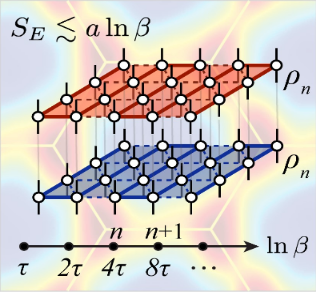On September 26, 2018,Physics Review X(PRX),the world-class scientific journal withimpactfactor of 14.4 published an articlewith the title of“Exponential thermal tensor network approach for quantum lattice models”by researchers from the Micro-Nano Physics and Application Research Group, the School of Physics, Beihang University and other laboratories. The work is led by Li Wei, associate professor at the Micro-Nano Physics and Application Research Group and Dr, Weichselbaum, a member of the Brookhaven National Laboratory (BNL) as co-corresponding authors. 2015 Ph.D student Chen Bin-bin at Beihang University, supervised by Prof. Chen Ziyu and 2013 undergraduate student Chen Lei are co-first authors.Physics Review Letters,one of the most prestigious journals in the field of physics, focuses on academic innovation and creation. It publishes a total of less than 300 papers selected from different sub-disciplines and branches.

Fig.1 the Exponential Tensor Renormalization Group (XTRG):This approach is to multiplythe density operator of the system by itself to obtain a lower temperature (2 timestemperatureinversion) density operator. Inspired by the upper bound of the entanglement of the finite temperature state with the inverse temperature logarithm divergence (theupper left formula), the thermodynamic simulation of the system varies uniformly along the logarithmic temperature axis, throughwhichan exponentially accelerated cooling is obtained.TheXTRGapproachcan be used to calculate the thermodynamic properties of a resistive lattice antiferromagnetic body. The background shows the finite temperature structural factor of a triangular lattice antiferromagnetic.
The interacting atoms form a variety of materials in the material world, where novel associative quantum materials such as high-temperature superconductors and spin liquids have extraordinary electronic structures and magnetic properties. It is urgent to carry out computational simulation studies on these quantum materials from the microscopic model, to explore their properties and to find potential applications in areas such as quantum computing. However, due to the complexity of the quantum multi-body problem itself and the strong entanglement properties caused by the correlation effect, it is very difficult to develop accurate and effective simulation methods. In particular, the calculation of the two-dimensional fermion problem, is called the "Holy Grail" problem of condensed matter physics because of its close connection with high-temperature superconductivity. How to solve this bottleneck problem and promote the research of related quantum materials is an important academic frontier.
In order to obtain a density operator for a given temperature, theconventionalsimulation method starts with an infinite high temperature and allows the system to linearly cool down the inversetemperature axis. Inspired by the finite temperature entanglement of the system with the logarithmic growth of the inversetemperature, Associate Professor Li Wei and his team membersas well aspartners collaborated to develop a newapproach, namely theExponentialTensorRenormalizationGroup (XTRG) and program it specifically. Unlike traditional methods,theXTRGapproachuses a method of exponentially cooling down along the inversetemperature axis, which allows for more efficient and accurate simulation of the thermodynamic properties of quantum multi-body systems at low temperatures (see Fig.1).This approachcan also be used to compute two-dimensional quantum multi-body systems, with very attractive prospects for high-profile issues including frustration spins and associated fermion models and material studies.
Associate Professor Li Wei has been working in this fieldfor years. During his Ph.D period,he and his supervisorproposed a thermaltensor network and its linear renormalization groupapproach[Phys. Rev. Lett. 106, 127202 (2011)]. In 2015, after joining the School of Physics of Beihang University under the support of Beihang ExcellenceProgramfor Talents, he continued to make progress withhiscollaborators in thefieldof thermaltensor renormalization group, and successively published many international high-level academic papers, includingthe Conformal Field Theory and Universal Thermodynamics on Non-Directional Topological Manifolds [Phys. Rev. B 96, 174429 (2017), Phys. Rev. B 97, 220407(R) (2018)], Two-Layer Thermodynamic Tensor Network Method [ Phys. Rev. B 95, 144428 (2016)], Series Expansion Thermal Tensor Network [Phys. Rev. B 95, 161104 (R) (2017)].Many excellent undergraduates from theSchoolof Physicsof Beihang Universitysuch as2013Chen Lei, LiuYunjing and 2014Wang Haoxin,participatedinand made greatcontributionto part of the work. Theseoutcomeshave laid an important technical foundation for thethisbreakthrough of the XTRG algorithm.
Theworkwas supported by the National Natural Science Foundation of China,the National Key Research and Development Program of ChinaandBeihang Excellence Programfor Talents.
The research article is available at:
https://journals.aps.org/prx/abstract/10.1103/PhysRevX.8.031082